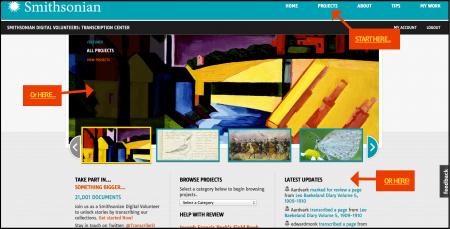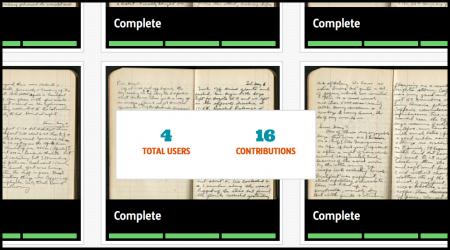In just over a year, the Smithsonian Transcription Center has grown in size, scope, and participation. Every day, members of the volunteer community visit the Transcription Center to split projects into tasks and share their discoveries with us.
We have 956 active contributors on the site and we’ve completed over 13,412 pages, from 18,494 available pages. Over 450 volunteers have worked on the 46 different Archives projects; there are over 75 other projects in the Transcription Center. Volunteers made connections between Smithsonian collections, to other cultural heritage institutions, and opened doors to discovery while transcribing. Through daily work and targeted campaigns, our volunteers have moved from individuals to a community of “volunpeers” – taking pride in the ways they’re learning with us in this pan-Smithsonian project.
As we opened to the public last summer, we knew volunpeers would have to “work together,” yet we didn’t know what that would look like. What we've discovered are the ways that they use the features of the site and other tools to interact - indirectly and directly.
So, how do volunteers get integrated into the community? Typically by transcribing! From the homepage, there are 3 ways to jump into projects: from the main carousel "Featured Projects," from the dropdown "Projects menu," and in the "Latest Updates" section. Some volunpeers tell us that they check the "Latest Updates" section to see what others are working on - then they'll join a project that looks like it needs help (or looks interesting). Volunpeers also explain how they return to projects using the browse by Museums & Archives feature to check on their progress.

Many volunteers use the Notes feature we implemented on all projects in the Transcription Center this spring. This box under the transcription field allows them to communicate with the Smithsonian staff sharing the project and also share or discuss information with other volunpeers. For example, in the recently posted Lepidoptera notes project:

Here’s some insight into collaboration on a project: There are 34 completed Archives projects in the Transcription Center, with an average size of 83 pages and 25 contributing volunpeers each. When you enter a project page, you can see the status of each page and, by hovering over the thumbnails, how many people have worked on each page.

Let’s look at a completed project: Botanist Ellsworth Paine Killip’s field notes from Colombia (1944). This Archives (and Field Book Project) project is 59 pages and was completely transcribed and reviewed by 12 volunpeers. We can see collaboration on a microscale by looking at the number of members and contributions it took to finish a page. For Killip’s field notes, that was an average of 4 volunpeers and 12 contributions per page. That suggests that peer review is a process that can inform reliable results in the Transcription Center.
The excitement of releasing a new project continues as volunpeers start reporting discoveries via tweets, Facebook wall posts, and feedback e-mails. Using Twitter and Facebook, volunpeers will ask other #volunpeers for help and share what they’ve discovered. They also invite other interested parties to join the transcribing adventure.
We find that allowing people to communicate using tools they already use facilitates better collaboration. We are able to respond to questions and discoveries via social media; or highlight complicated pages, or share praise for completed projects, allowing us to communicate more widely with our community. If you transcribe with us, we'd love to know whether you find this helpful and how we can do it better (get in touch!).
The adventure continues! As new projects are added almost every week, you can join other volunpeers while you choose-your-own-adventure. Tell us more about your experiences with transcribing – follow and tweet @SmithsonianArch and @TranscribeSI on Twitter or drop us a note.
Related Resources
- What's in a Word?, The Bigger Picture blog, Smithsonian Institution Archives
- Embracing the Crowd, The Bigger Picture blog, Smithsonian Institution Archives
- Get to Know Joseph Nelson Rose, Field Book Project blog, Field Book Project
Produced by the Smithsonian Institution Archives. For copyright questions, please see the Terms of Use.

Leave a Comment